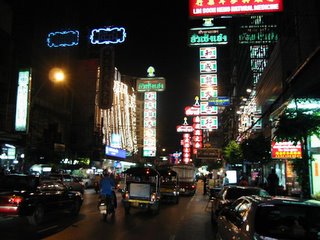 In 1782 when Rama I, first king of the new Chakri dynasty, moved the capital to Bangkok and began building the Grand Palace, the traders were relocated to a small alley called Sampeng Lane, the nexus of today's China Town.Today, the narrow pedestrian lane is packed with wholesale stores selling paper, fabric and bric-a-brac, and teems with haphazardly roving snack merchants and careering motorbikes overloaded with wide bolts of fabric.
In 1782 when Rama I, first king of the new Chakri dynasty, moved the capital to Bangkok and began building the Grand Palace, the traders were relocated to a small alley called Sampeng Lane, the nexus of today's China Town.Today, the narrow pedestrian lane is packed with wholesale stores selling paper, fabric and bric-a-brac, and teems with haphazardly roving snack merchants and careering motorbikes overloaded with wide bolts of fabric.
China Town has always been synonymous with commerce. At almost any hour, someone is selling something somewhere in China Town. Even before the first Bangkok department stores opened on Yawarat in the 1930s, the China Town markets sold goods found nowhere else in the city.
Locals believe that they owe this good fortune, wealth and prosperity to the mythical Golden Dragon, the guardian spirit that has watched over the community for centuries.
To first-time visitors, China Town can seem like a daunting maze of traffic- and people-choked lanes and alleys. Yet to fully appreciate the panoply of sights, sounds and smells that give China Town its unique character, it's essential to wander off the beaten track where such hidden delights as 100 year-old shrines, tiny neighbourhoods and countless other treasures await. (A major thoroughfare is rarely more than a block away so getting lost isn't really a problem.)
It's easy to spend an entire morning or afternoon visiting temples (Buddhist, Taoist, Chinese, Sikh and Chinese shrines). Others might choose to focus on China Town's many markets (food, clothing, electrical goods, hardware, audio) or wander along streets devoted to a single product. The area abounds with restaurants (from fancy indoor eateries to open-air stalls) and unusual juxtapositions: a modern fast-food restaurant next to a vendor roasting chestnuts in a streetside wok; Chinese herbs adjacent to Buddhist temple supplies.
This ad-hoc method of seeing the sights isn't nearly as intimidating as it sounds. Almost every square block of China Town boasts temples shrines, markets, restaurants, and unusual juxtapositions. Thoroughly covering one area can be as much fun as rushing here and there to take in 'important' sights. Oh, and don't forget to look up. With so much attention-grabbing activity at street level, visitors can easily overlook the ornate neo-colonial columns, delicately carved shutters and second-floor balconies (often half-hidden behind electrical transformers and telephone cables.)
Whichever aspects of China Town you decide to explore, the most important accoutrements are light clothing, comfortable shoes, plenty of liquids, and above all, a spirit of adventure. A good map is also helpful (Nancy Chandler's Map of Bangkok highlights scores of sightseeing and shopping tips in an easy-to-read graphical format). Don't forget, however, that China Town's vibrancy is an essentially intangible quality that transcends the confines of cartography.
 In 1782 when Rama I, first king of the new Chakri dynasty, moved the capital to Bangkok and began building the Grand Palace, the traders were relocated to a small alley called Sampeng Lane, the nexus of today's China Town.Today, the narrow pedestrian lane is packed with wholesale stores selling paper, fabric and bric-a-brac, and teems with haphazardly roving snack merchants and careering motorbikes overloaded with wide bolts of fabric.
In 1782 when Rama I, first king of the new Chakri dynasty, moved the capital to Bangkok and began building the Grand Palace, the traders were relocated to a small alley called Sampeng Lane, the nexus of today's China Town.Today, the narrow pedestrian lane is packed with wholesale stores selling paper, fabric and bric-a-brac, and teems with haphazardly roving snack merchants and careering motorbikes overloaded with wide bolts of fabric.

































0 Comments:
Post a Comment
<< Home